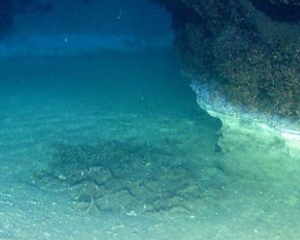Deep sea submersibles made an even more extraordinary discovery in 1990.
在1990年,深海潜水艇有了更惊人的发现。
Over half a mile down at the bottom of the Gulf of Mexico, they came across what appeared to be an underwater lake over twenty metres long, with its own sandy shore.
就在墨西哥湾一英里半的海底,他们发现了一座超过20公尺宽,甚至还有沙岸的海底湖。
Around its edge, there even seemed to be a tide line. But this couldn't be, of course, this was underwater.
在湖边的地方似乎还有潮线的存在。这应该是不可能的,因为这里可是海底。
In fact, the lapping edge was created by a thick soup of salty brine, far heavier than the surrounding seawater, and the sand was made up of hundreds of thousands of mussels.
这个湖其实是由一层厚厚的盐水所形成,比重比周围的海水重许多,岸边的沙则是无数的贻贝组成的。
Once again, in the midst of a totally barren seabed, an extraordinarily rich oasis of life, totally independent of the sun's energy.
这里也是在一片荒凉的海底,一座孕育丰富生命的神奇绿洲,完全不依赖太阳能。
The source of energy this time was not sulphides, but methane bubbling out of the sea bed.
这里的能量来源不是硫,而是从海床上升起的甲烷。
And once again, the mussels carried special bacteria capable of fixing the methane's energy.
这里的贻贝也带有特殊的菌种,可以转化甲烷制造能源。
Just like the hot vents, a complete ecosystem had developed, based on the bacteria.
与海底烟囱一样,这也是个建筑在细菌之上的完整生态系统。
There was an enormous variety of completely new species, shrimps, weird squat lobsters and bright red polychaete worms.
这里有许多新物种,虾子,奇怪的短龙虾,还有鲜红色的多毛虫。
These oases were called cold seeps and were surprisingly similar to the hot vents.

The geological processes in the sea floor that produce methane also tend to result in the release of hydrogen sulphides.
会在海床造成甲烷的地质变化,也会造成硫化氢的释放。
It was hardly surprising then when not far from the brine pool they found tube worms, extensive fields of tube worms that stretch for hundreds of metres.
所以科学家在盐水湖附近会发现管虫实在不足为奇,管虫聚集成广大一片,绵延数百公尺。
This new species also uses bacteria to fix energy from sulphides, but it extracts them directly from the ground.
这个新品种身上也有细菌,会利用硫来转化出能源,但它们会直接从地面撷取硫。
Their beautiful gills are only used to supply oxygen to the bacteria. Amazingly, these tube worms are over two hundred years old.
它们美丽的鳃只有供给细菌氧气的功用。但惊人的是,这些管虫已经超过两百岁了。
While hot vent tube worms are thought to be the fastest growing invertebrates in the sea, these appear to be far slower.
有人认为海底烟囱的管虫是海洋中长的最快的无脊椎动物,而这些管虫却长得奇慢。
All the more reason to protect your gills from biting amphipods.
所以更应该保护自己的鳃不受排骨虾的侵扰。
The energy sources exploited by the hot vent animals may suddenly fail, but here life can enjoy a more stable geological future.
海底烟囱可能突然熄灭,赖以维生的生物可能顿失所依,在这里生物的远景则较有保障。
To discover within ten years two completely new ecosystems, both totally independent of the sun's energy, has been quite extraordinary.
能在10年间发现两个完全不依赖阳光的新生态系统,实在是不可思议。
So far, we have explored just one per cent of the deep ocean floor. Who knows what is still out there to be discovered?
直到现在为止我们只探索过深海床不到1%的部分。谁又知道还有什么不为人知的事物在等待我们去发掘呢?



